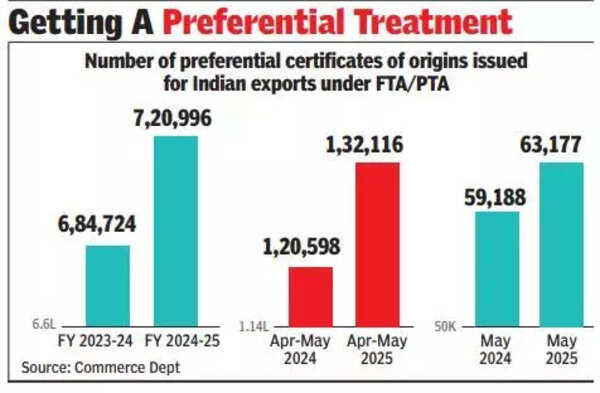ARTICLE AD BOX

NEW DELHI: India has drawn up a four-pronged strategy for free trade agreements (FTAs), focused on developed economies, mineral-rich countries, developing nations, and neighbours.
The first element is likely to be in place by the year-end through agreements with the US and the European Union.But with negotiations from Chile and Peru to Australia and New Zealand underway, the commerce department is bolstering its negotiating teams while also seeking to ensure that the available preferential tariffs are used by exporters. Recent data suggests that there is now better utilisation of preferential tariffs, especially when it comes to the ones such as UAE, although disaggregated numbers for each country are still being collated by the commerce department.With the benefit of hindsight, the Modi govt, which did not proceed on any of the FTAs in the pipeline until it decided against joining China-led RCEP a few years ago, has a strategy in place with complementarities being the first pillar. "If we are competing for the same set of products, it does not make sense to have an FTA," said an official.

Getting a preferential treatment
As a result the first batch of FTAs are the ones with developed countries, which because of the cost structure are less competitive in the labour-intensive space, although it also meant that India has had to shun its traditional reluctance to cutting duties for some of the sectors that were regarded sensitive, such as auto and wine and alcohol.
While the UK deal has been finalised, EU and the US are in sight and India and Canada have decided to resume dialogue.While some of India's neighbours are no-go areas, such as China and Pakistan, countries like Sri Lanka and Mauritius are among those where govt has shown a willingness to move ahead with talks.At the same time, govt is seeking to secure critical minerals and resources from countries such as Australia (where a chapter is proposed in the expanded trade pact) to Chile, Peru and countries in the Gulf region.
Some of these countries also fall in the developing country bracket, a segment which is expected to be in focus in the coming years.While the negotiations go on, the commerce department has also sought to bolster its teams engaged in talks, keeping continuity as a key parameter. For almost all negotiations, a team headed by a chief negotiator, who is of the level of additional secretary, along with two joint secretaries is being put in place.There are also efforts to strengthen the skills in other ministries, given that talks are sectoral, including agriculture, labour and multiple industrial goods. The Indian Institute of Foreign Trade has been roped in to devise modules, including ones for the private sector, a senior official said. In any case, the learnings from the negotiations are being documented with SOPs now being readied.



.png)
.png)
.png)
















 5 hours ago
4
5 hours ago
4









 English (US) ·
English (US) ·